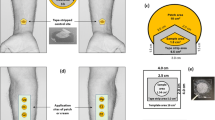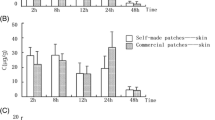Abstract
Purpose. The objectives of dermal application of drugs are not only systemic therapeutics, but also local ones. We would expect its intradermal kinetics to be dependent on its therapeutic purpose. To develop more efficient drugs for local or systemic therapeutics, it will be important to estimate quantitatively the intradermal disposition of drugs applied topically. We tried, therefore, to develop the compartment model to describe the intradermal disposition kinetics after topical application of drugs.
Methods. In vivo percutaneous absorption study for antipyrine, a model compound, was performed using rats with tape-stripped skin, using the assumption that the stratum corneum permeability to drugs would be improved enough not to be a rate-limiting process.
Results. To analyze the results obtained, a 4-compartment model, composed of donor cell, viable skin, muscle, and plasma compartments, was applied. Although the fitting lines obtained could describe the concentration-time profiles of antipyrine in each compartment very well, the concentration profiles in the contralateral tissues were extensively overestimated. Therefore, we developed a 6-compartment model which included the viable skin and muscle in the contralateral site, and analyzed the concentration-time curve of each compartment. The fitting curves were in good agreement with the experimental data for all the compartments including the contralateral viable skin and muscle, and thus, this model was recognized to be adequate for the estimation of intradermal kinetics after topical application. Judging from the obtained values of clearance from viable skin to plasma and from viable skin to muscle, about 80% of antipyrine penetrated into viable skin, which suggested it was absorbed into circulating blood and 20% was transported to muscle under viable skin.
Conclusions. Pharmacokinetic analysis using the 6-compartment model would be very useful for the estimation of local and systemic availability after topical application of drugs.
Similar content being viewed by others
REFERENCES
M. Hashida, E. Mukai, T. Kimura, and H. Sezaki. Enhanced delivery of mitomycin C prodrugs through the skin. J. Pharm. Pharmacol. 37:542–544 (1985).
S. Y. Chan and A. Li Wan Po. Prodrugs for dermal delivery. Int. J. Pharm. 55:1–16 (1989).
F. Palagiano, L. Arenare, F. Barbato, M. I. La Rotonda, F. Quaglia, F. P. Bonina, L. Montenegro, and P. de Caprariis. In vitro and in vivo evaluation of terpenoid esters of indomethacin as dermal prodrugs. Int. J. Pharm. 149:171–182 (1997).
A. C. Williams and B. W. Barry. Skin absorption enhancers. Crit. Rev. Ther. Drug Carrier Sys. 9:305–353 (1992).
N. Ohara, K. Takayama, Y. Machida, and T. Nagai. Combined effect of d-limonene and temperature on the skin permeation of ketoprofen. Int. J. Pharm. 105:31–38 (1994).
Y. Nakamura, K. Takayama, K. Higashiyama, T. Suzuki, and T. Nagai. Promoting effect of O-ethylmenthol on the percutaneous absorption of ketoprofen. Int. J. Pharm. 145:29–36 (1996).
J. Hadgraft, K. A. Walters, and P. K. Wotton. Facilitated transport of sodium salicylate across an artificial lipid membrane by Azone. J. Pharm. Pharmacol. 37:725–727 (1985).
Y. W. Chien, O. Siddiqui, W. M. Shi, P. Lelawongs, and J. C. Liu. Direct current iontophoretic transdermal delivery of peptide and protein drugs. J. Pharm. Sci. 78:376–383 (1989).
P. Singh, M. S. Roberts, and H. I. Maibach. Modelling of plasma levels of drugs following transdermal iontophoresis. J. Contr. Rel. 33:293–298 (1995).
J. E. Riviere and M. C. Heit. Electrically-assisted transdermal drug delivery. Pharm. Res. 14:687–697 (1997).
B. W. Barry. Lipid-protein-partitioning theory of skin penetration enhancement. J. Contr. Rel. 15:237–248 (1991).
J. Radermacher, D. Jentsch, M. A. Scholl, T. Lustinetz, and J. C. Frolich. Diclofenac concentrations in synovial fluid and plasma after cutaneous application in inflammatory and degenerative joint disease. Br. J. Clin. Pharmacol. 31:401–418 (1991).
M. Dawson, C. M. McGee, J. H. Vine, P. Nash, T. R. Watson, and P. M. Brooks. The disposition of biphenylacetic acid following topical application. Eur. J. Clin. Pharmacol. 33:639–642 (1988).
J. P. Marty, R. H. Guy, and H. I. Maibach. I. Percutaneous penetration as a method of delivery to muscle and other tissues. In R. L. Bronaugh and H. I. Maibach (eds.), Percutaneous Absorption: Mechanisms, Methodology, Drug Delivery (2nd ed.), Marcel Dekker, New York, 1989, pp. 511–529.
P. Singh and M. S. Roberts. Dermal and underlying tissue pharmacokinetics of salicylic acid after topical application. J. Pharmacokinet. Biopharm. 21:337–373 (1993).
M. Yamazaki, H. Suzuki, M. Hanano, T. Tokui, T. Komai, and Y. Sugiyama. Na+-independent multispecific anion transporter mediates active transport of pravastatin into rat liver. Am. J. Physiol. 264:G36–G44 (1993).
K. Yamaoka and T. Nakagawa. A nonlinear least squares program based on differential equations, MULTI(RUNGE), for microcomputers. J. Pharmacobio-Dyn. 6:595–606 (1983).
T. Iga, Y. Sawada, and Y. Sugiyama. Physiological pharmacokinetics: the method of parameter calculation. In M. Hanano, T. Umemura, and T. Iga (eds.), Applied Pharmacokinetics: Theory and Experiments, Soft Science Inc., Tokyo, 1985, pp. 431–473.
K. Yamaoka, T. Nakagawa, and T. Uno. Application of Akaike's information criterion (AIC) in the evaluation of linear pharmacokinetic equations. J. Pharmacokinet. Biopharm. 6:165–175 (1978).
P. Singh and M. S. Roberts. Dermal and underlying tissue pharmacokinetics of lidocaine after topical application. J. Pharm. Sci. 83:774–782 (1994).
P. Singh and M. S. Roberts. Local deep tissue penetration of compounds after dermal application: structure-tissue penetration relationships. J. Pharmacol. Exp. Ther. 279:908–917 (1996).
Author information
Authors and Affiliations
Corresponding author
Rights and permissions
About this article
Cite this article
Nakayama, K., Matsuura, H., Asai, M. et al. Estimation of Intradermal Disposition Kinetics of Drugs: I. Analysis by Compartment Model with Contralateral Tissues. Pharm Res 16, 302–308 (1999). https://doi.org/10.1023/A:1018844928818
Issue Date:
DOI: https://doi.org/10.1023/A:1018844928818




